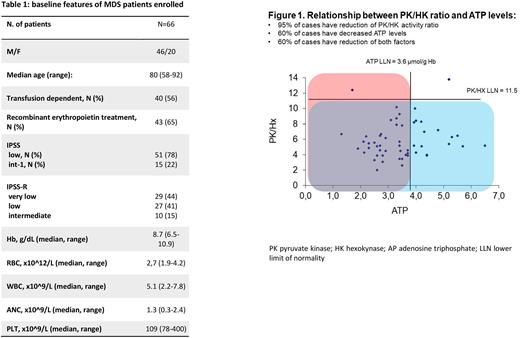Abstract
Low risk myelodysplastic syndromes (MDS) show high clinical heterogeneity ranging from mild anemia with nearly normal performance status to life-threatening cytopenias, frequent hospitalization, and disability. Anemia occurs in 80%-85% of patients and therapeutic strategies are still very limited mainly consisting of of erythropoiesis stimulating agents and red blood cell (RBC) transfusion support. Starting from the working hypothesis that the defective maturation of hematopoietic precursors may dampen the "functionality" of MDS-RBCs, we aimed at evaluating RBC metabolic pathway in anemic patients with LR-MDS. We focused on the glycolytic pathway, which is the prominent metabolic cascade in RBCs and is currently targeted with allosteric stimulators of pyruvate kinase (PK) enzyme in clinical trials of PK deficiency, thalassemia, and sickle cell diseases, which are also marked by ineffective erythropoiesis like MDS.
Sixty-six consecutive anemic patients (i.e. Hb<11 g/dL) diagnosed with MDS according to WHO 2016 classification that met IPSS-R criteria for very low, low, or intermediate-risk MDS were enrolled in the study. All patients were sampled for peripheral blood at least 4 weeks after the last RBC unit to reduce possible blood donor contamination. The determination of activities of the glycolytic RBC enzymes pyruvate kinase (PK) and hexokinase (HK) (the terminal and initial steps of the glycolytic pathway), and of ATP levels was performed by standard spectrophotometric method according to Beutler et al, 1984. 2,3 DPG determination was tested by AssayGenie Kit in a subgroup of patients. Ektacytometric analysis by LoRRca MaxSis (Laser-Assisted Optical Rotational Cell Analyzer, Mechatronics, NL) was also performed in a subgroup of patients.
As shown in table 1, patients were mainly elderly males, and mostly belonged to IPSS low (78%) and IPSS-R very low/low groups (85%). Median levels of PK activity were 13.7 IU/gHb, with a wide range (7.5-35.9) and were reduced in 23 cases (35%; normal reference range 11.9-16.7 IU/gHb); median values of HK activity were 2.3 (0.8-8.1), increased in 60 patients (91%; normal reference range 0.78-1.32 IU/gHb). This resulted in an abnormally reduced PK/HK ratio (median 5.45, range 2-15) in 63 subjects (95%; (normal reference range calculated on 167 normal subjects: 11.55 - 17.65). To asses if impaired glycolysis may result in altered RBC deformability or in lack of energy, ATP levels, 2,3 DPG, and ektacytometric curve were evaluated. Median ATP levels were 3.4 mcM/gHb (1.3-6.5), reduced in 33/56 tested patients (59%; normal reference range 3.6-4.9 mcM/gHb), of whom 32 had simultaneous reduction of PK/HK activity ratio (figure 1), and 11 decreased PK activity. Concerning 2,3 DPG levels preliminarily analysed in a subgroup of patients, they were close to the upper limit of the normal range (median, 389 nM/gHb, 318-639). Osmoscan, performed in 10 patients did not show altered RBC deformability.
Preliminary data show decreased glycolytic activity in RBCs from patients with LR-MDS highlighted by reduced PK activity in more than 1/3 of cases, and increased HK activity in almost all subjects. This results in reduced RBC ATP content in up to 2/3 of patients (possibly due to reduced production or to increased consumption) indicating an overall lack of energy in MDS-RBCs. The latter may be an interesting target for allosteric PK stimulators and warrants further investigations.
Disclosures
Fattizzo:Novartis: Speakers Bureau; Alexion: Speakers Bureau; Sobi: Speakers Bureau. Barcellini:Alexion: Honoraria; Apellis: Honoraria; Biocryst: Honoraria; Incyte: Membership on an entity's Board of Directors or advisory committees; Momenta: Honoraria; Janssen: Honoraria; Novartis: Honoraria; SOBI: Honoraria; Bioverativ: Membership on an entity's Board of Directors or advisory committees; Agios: Honoraria, Research Funding; Sanofi: Honoraria, Speakers Bureau.
Author notes
Asterisk with author names denotes non-ASH members.


This feature is available to Subscribers Only
Sign In or Create an Account Close Modal